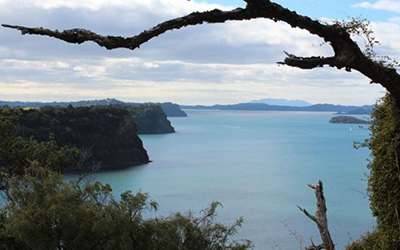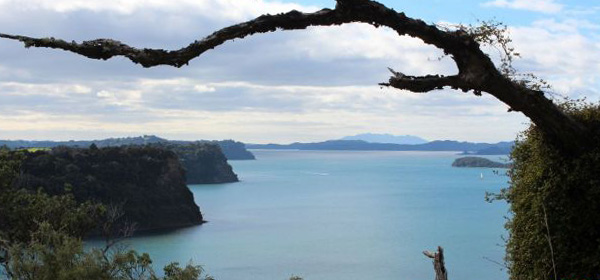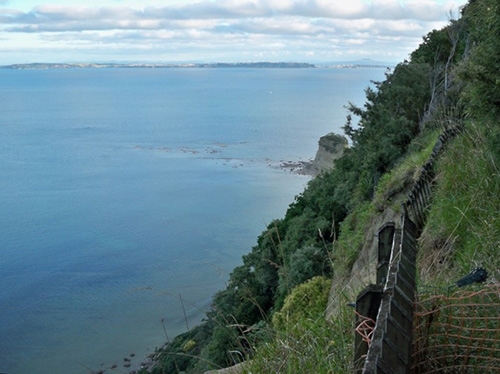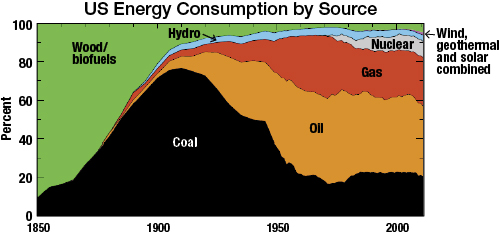Mahurangi Coastal Trail high-tide Seaweek walk

Corrected 25 February 2014

Headlands All in a Row: The bluffs of Te Muri, Cudlip Point and that beyond Big Bay lining up perfectly to the left, Saddle Island and Motutara to the right, is just part of the stunning panorama presented at the Maungatauhoro lookout, on Te Araroa—the national walkway. image MyDestination
Last year’s was a low-tide walk, and wade, with the odd wallow.
Partly to demonstrate that the Pūhoi River can be readily be crossed at low tide, and partly to avoid the need to arrange for craft to ferry folk across, the Mahurangi Coastal Trail was done entirely on foot.
Crossing the knee-deep Pūhoi, from adjacent the old Schischka farmhouse, was the least demanding aspect of the low-tide crossing, particularly for those with footwear dedicated for such work. The more challenging section was 350-metre walk along tidal platform and across Spaniards Creek, which included both slick-rock and deep-mud hazards.
This year, to coincide with the second Sunday of Seaweek, 9 March, a 2.20 pm high tide, and the Waiwera bus timetable, the walk will start, weather permitting, at the southern abutment of the old Waiwera Bridge, at 12.40pm. From there, there will be two options:
- Briefly follow the Perimeter Track to the left, then take the Pūhoi Track, then the upper Couldrey House Track, then left around the Perimeter Track to the achingly beautiful vista from the Maungatauhoro lookout. Thence to the Wenderholm Jetty, via the Maungatauhoro te Hikoi Track and past Couldrey House. The Perimeter Track – Maungatauhoro te Hikoi Track section is part of the national walkway: Te Araroa.
- The less-energetic option involves taking the Perimeter Track to the left, but continuing along it as it shadows the State Highway 17, Schischka Road and the road into the park. Depending upon numbers, walkers taking this option may be ferried across to Spaniards Creek ahead of the Maungatauhoro walkers.
After the ferry ride, walkers will face Te Muri saddle, which while only at a 50-metre elevation, if the steep farm track is taken, is a less-than-gentle post-luncheon stroll. The more scenic alternative is to follow the leader on a slightly more circuitous route that also provides better high-tide vistas of the Wenderholm spit, and the perfect place for walkers to sit and eat the picnic lunches they have brought with them, while listening to civil engineer Roger Williams summarise the report he has prepared for regional parks management’s consideration. A draft of the report has already been discussed with Auckland Regional Parks parks and recreation advisor Neil Olsen and northern regional parks principal ranger Mathew Vujcich. It is anticipated that the report will help inform the Te Muri Regional Park concept plan, when it is drafted—the timetable for this is yet to be decided. The main infrastructure needed is a 300-metre long walk bridge, with a lifting span to allow yachts and larger boats to navigate as far as the State Highway 1 road bridge, estimated to cost $600 000. While that might sound insurmountable at first blush, the alternative, of upgrading the farm track to a standard suitable for two-way car access is likely to cost in excess of $3 million. Not only would such car access spoil the sense of splendid isolation that is the essence of Te Muri, it would ruin the ridge trail’s natural potential as spectacularly scenic section of Te Araroa, delivering walkers into the bosom of the greater and contiguous Mahurangi – Te Muri – Wenderholm regional parks. At present Te Araroa, between Pūhoi and Wenderholm, is the Pūhoi River. While this is a grand option when tide and weather are favourable, not all walkers, for whatever reason, would wish to hire and paddle kayaks.

James E Hansen: ‘I also recommend that the public stop providing funds to antinuke environmental groups. Send a letter saying why you are withdrawing your support.‘ image https://www.facebook.com/jimehansen
The sight of the Wenderholm spit is a sight to be deeply savoured, given that it will likely not exist by the end of this century—27% of sea-level rise experts currently anticipate that the rise will be 2 metres or more by 2100, assuming greenhouse gas emissions continue their stubborn inexorable rise. Given that the last time carbon dioxide levels were in the region of 400 parts per million, probably more than 3 million years ago, the sea level was somewhere between 10 metres and 20 metres higher, that 2-metre rise is only the beginning. Nor, sadly, is it a case of what goes up must come down. Even if all fossil-fueled industry, transport and domestic heating was to cease tomorrow, carbon dioxide, on human timescales, is forever—it is only on geological timescales that rock weathering can gradually scrub the surplus carbon from the atmosphere. As Dr James Hansen warns:
Sea-level rise, despite its potential importance, is one of the least well-understood impacts of human-made climate change. The difficulty stems from the fact that ice sheet disintegration is a complex non-linear phenomenon that is inherently difficult to simulate, as well as from the absence of a good paleoclimate analogue for the rapidly increasing human-made climate forcing.
The same, of course holds for the spit at Te Muri—a veritable miniature Wenderholm. Which is why the restoration of both spit’s dune sand-binding flora, and that of their back-dune forest, is an urgent priority, which could permit at least one further generation to enjoy these once-timeless gems before they are forever consigned to history.
Once sandspits such as these give up their unequal battle with galloping sea-level rise and are overwhelmed, the sea will largely be at liberty to carve into the soils and soft rocks of the hillsides beyond. There, mangroves will form an important defence, and will be the only thing standing between the sea and an even muddier coastline.

‘Mountain with the Eroding Cliffs’: An earlier safety fence now partly suspended in space highlights the natural erodibility of the Waitematā sandstones. But the rate will look glacial once sea-level rise drowns littoral rock platforms leaving waves to pound cliff bases unimpeded. image blog.daum.net/newzealand-wine
The Mahurangi regional parks are uniquely positioned to demonstrate how Aucklanders can play their part in limiting anthropogenic global warming. Wenderholm sits at the northern limit of the metropolitan public transport service, which means that a Mahurangi Coastal Trail would provide direct access to 790 contiguous hectares of regional parkland—with a Mahurangi Harbour ferry service, that could be 875 hectares. While many, including the Green Party, fancy that solar panels are the only thing standing between runaway global warming and salvation, countries relying upon them, such as Germany, are increasing their greenhouse gas emissions—thanks to the phasing out of nuclear power, to ideological ends. Meantime, some countries that courted solar power with feed-in tariff subsidies are finding the practice problematic; the practice has helped to bankrupt Spain.
The benefits of public transport are not confined to reducing emissions and include one of the few effective counters the rise and rise of non-communicable diseases that is plaguing developed and developing nations. It appears that even the small amount of extra walking folk do when not flopping straight into their own cars can make more difference than all the healthy eating and exercise propaganda. In fact, such public health initiatives have been found to have zero impact upon the crisis.
The original regional parks visionary, Frederick William Osborn Jones, saw access to the private car and regional parkland as the epitome of a healthy lifestyle—not an entirely unreasonable position, in the mid-1940s, when he became the region’s first metropolitan planner. Fortunately, for the parks within the metropolitan transport arena, little needs to be changed to have see, eventually, a majority of park users switching to public transport: A small charge made for park parking, and public transport made free, as advocated by the only mayoral candidate who offered policies capable of sustainably and affordably addressing the region’s transport woes: John Minto. Although Mahurangi Regional Park users in areas unserviced by public transport would be disadvantaged by a parking charge, the answer lies not in exempting such citizens from payment, but by extending the exemplary but struggling stop-to-stop and door-to-door Kowhai Connection.
In any event, for Sunday week’s Mahurangi Coastal Trail walk, public transport will again be laid on, even from the door if required, and will leave Warkworth at 11.50 am—connecting perfectly with the Kowhai Connection. Meanwhile walkers from the south can simply catch the 895 – Midtown to Waiwera bus that leaves the city at 11.10 am.

Popular Misconception: Image from the paper published by James Hansen, the day after this story, graphically illustrating the misconception that renewable energy—the pink, barely perceptible, slither—can prevent catastrophic global warming. image Renewable Energy, Nuclear Power and Galileo Relabelled by Mahurangi Magazine
Hot off the press Renewable Energy Nuclear Power and Galileo: Do Scientists Have a Duty to Expose Popular Misconceptions?
James E Hansen 21 February 2014

Great read Cimino. Alas will still make excuses for not taking the walk.